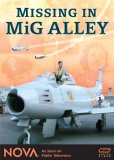| Reviews & Columns |
|
Reviews DVD TV on DVD Blu-ray 4K UHD International DVDs In Theaters Reviews by Studio Video Games Features Collector Series DVDs Easter Egg Database Interviews DVD Talk Radio Feature Articles Columns Anime Talk DVD Savant Horror DVDs The M.O.D. Squad Art House HD Talk Silent DVD
|
DVD Talk Forum |
|
|
| Resources |
|
DVD Price Search Customer Service #'s RCE Info Links |
|
Columns
|
|
|
NOVA: Missing in Mig Alley
Missing in MiG Alley is a 2007 episode of PBS television's NOVA series, produced by WGBH Boston. The hour-long program concentrates on the 30 or so Sabre Jet pilots that went missing in action over fifty years ago, in the United Nations' police action that later came to be known as the Korean War.
The handsomely assembled show begins with a historical setup for the Korean War, leading quickly to the dramatic standoff at the Yalu River, the border between North Korea and Communist China. On one side stood South Korea, the United States and its allies, and on the other the North Koreans, the Red Chinese and their silent partners the Soviets. The Americans began with an easy advantage because they dominated the skies and could bomb North Korea unopposed. Then the Soviets provided the Red Chinese with their formidable new MiG-15 fighter jet. Ironically, the MiG was made possible by an English gift of experimental Rolls-Royce jet engines: English pilots then had to fight against their country's own technology.
The Americans countered with the new F-86 Sabre Jet, a plane almost perfectly matched to its Soviet competition. American and British fighter jocks (some of them future astronauts, like Buzz Aldrin) engaged in duels almost daily in the skies over the Yalu.
The battles were fought under bizarre circumstances. Fearful of a MiG being captured, the Reds restricted where their planes could fly, while the US did not want our pilots to foray deeply into Chinese territory. Thus the actual combat was restricted to a narrow corridor dubbed "MiG Alley." The MiG was at first the better jet, but their pilots had nowhere near the training given the Americans. Russian pilots secretly flew missions, as the Soviet Union also wanted to use the fighting as a weapons proving ground. The conflict between North and South Korea became a proxy fight between East and West, with the fighter jets battling on the potential edge of World War III.
The Communists eventually captured one of our jets, while a North Korean pilot defected to Seoul, delivering a MiG-15 in perfect shape. Chuck Yeager was the first American to fly the jet. The Russians gained a lot of technology from their prize, especially when they studied the Sabre's sophisticated targeting system, which used a simple computer.
The show assembles combat footage and computer animation to describe the aerial fighting, which one expert describes as a 'swirling engagement': two aircraft rolling and spinning to evade the other's guns. Both sides carried heavy machine-cannons that rapid-fired large caliber shells. We learn a lot more about the combat basics than can be seen in the best feature film on the subject, Dick Powell's 1958 The Hunters, starring Robert Mitchum.
The show's second half deals with the lasting political and personal fallout from the era. When the war ended in 1953, the Chinese repatriated fifteen or so captured pilots. But over 30 U.S. and British fliers were never specifically accounted for. Investigators determined that some of them had been taken to the USSR. It was feared that they might have ended their days in Gulag labor camps.
The 1989 fall of the Soviet Union renewed hope for many relatives of missing pilots. But only a couple of them have been identified; records are often unclear whether or not a pilot was recovered alive when his plane was shot down. So much time has elapsed that the now middle-aged children of the pilots, most of whom never really knew their fathers, are the ones hoping for definitive answers. We see DNA testing confirming that a few bits of powdered bone are indeed the remains of one fighter jock of over fifty years in the past.
Informative and unencumbered by a specific political viewpoint, Missing in MiG Alley covers its subject well. A good companion video for those wanting to learn even more about these first jet fighters is Aircraft Films' F-86 Sabre, from 2004.
WGBH's Missing in MiG Alley is presented in a good enhanced widescreen presentation, with most of the combat footage (much of it rare) in very good shape. The show begins with a full TV opening including an ad for the sponsor (Dow Chemical); we should be happy that we're spared a fund-raising commercial for public television. The only extra is a DVD-ROM study guide with 'printable materials for educators.
On a scale of Excellent, Good, Fair, and Poor, Missing in MiG Alley rates:
Movie: Excellent
Video: Very Good
Sound: Excellent
Supplements: DVD-ROM educational materials
Packaging: Keep case
Reviewed: March 10, 2008
Reviews on the Savant main site have additional credits information and are more likely to be updated and annotated with reader input and graphics.
|
| Popular Reviews |
| Sponsored Links |
|
|
| Sponsored Links |
|
|
| Release List | Reviews | Shop | Newsletter | Forum | DVD Giveaways | Blu-Ray | Advertise |
|
Copyright 2024 DVDTalk.com All Rights Reserved. Legal Info, Privacy Policy, Terms of Use,
Manage Preferences,
Your Privacy Choices | |||||||













